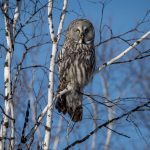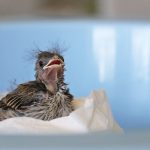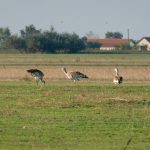I have heard both that most die and never make it back to their breeding grounds and that they do return to the north to make more Snowy Owls. So, which is it?
This article makes it seem like they are all starving. Does anyone have any solid data?
I have heard both that most die and never make it back to their breeding grounds and that they do return to the north to make more Snowy Owls. So, which is it?
This article makes it seem like they are all starving. Does anyone have any solid data?
 In search of the Citril Finch
In search of the Citril Finch Podcast: Hannah and Erik Go Birding; Tala Game Reserve & Wakkerstroom
Podcast: Hannah and Erik Go Birding; Tala Game Reserve & Wakkerstroom Species Spotlight: Great Grey Owl
Species Spotlight: Great Grey Owl Bird Guides of the World: Daniel Edelstein, California, USA
Bird Guides of the World: Daniel Edelstein, California, USA Top 10 Onomatopoeia
Top 10 Onomatopoeia Ask a Birder: What to do when encountering a baby songbird outside of a nest?
Ask a Birder: What to do when encountering a baby songbird outside of a nest? Birding in Portugal: A Brief Trip
Birding in Portugal: A Brief TripLearn about our site and writers, advertise, subscribe, or contact us. New writers welcome – details here!
| DAY | WRITER(S) | SERIES |
|---|---|---|
| MON | Kai (w) | Birding Lodges (w) |
| TUE | Donna (m) Susan (m) Hannah (m) Fitzroy (m) | Bird Guides (w) |
| WED | Leslie (bw) Faraaz (bw) | Ask a Birder (w) |
| THU | Paul (w) | Birder’s Lists (w) |
| FRI | David (w) | Species Spotlight (w) |
| SAT | Peter (bw) Luca (bw) | From the Archives (w) |
| SUN | Clive (w) Valters (bw) | Three Photos (w) |
| w weekly, bw biweekly, m monthly | ||
| Any time: Jason, Mark, John, Sara, Rolf, Dragan | ||
See here for info on the writers.
Signup and receive notice of new posts!
You have successfully joined our subscriber list.

From what I understand, the irrupting owls tend to be immature, and most immature birds die in their first year. For hawks, the figure is something like 70% mortality, and I think it’s even higher for songbirds. So it would make sense for the irrupting owls to have high mortality and not return to the Arctic. At the same time I would think that an owl that found a good wintering site and managed to survive through the winter (like the one currently at Merrill Creek Reservoir) would be a good bet to make it back to suitable breeding grounds.
It doesn’t sound like there’s much solid data there, particularly when phrases like “Snowy Owls don’t migrate” are casually tossed out. Interesting article though, 16 is a lot of birds, although their low survival rate is not surprising (Im sure all the broken-winged birds were euthanized).
Yup, John is right. First year birds have it rough!
As I understand it, this is an irruption of abundance rather than famine on the breeding grounds. The lemming crop is robust by all accounts. If that’s the case, we’re seeing young owls here not because food was scarce, but because there were so many owls that territory was scarce. Following that line of reasoning, these owls probably are doomed because there won’t be much more real estate available now than there was in the fall.
I have no data to back that up, just conjecturing as I go along…
Curious if the two owls we saw are still hanging around??
Interesting point, Kirby. Kind of makes the issue of surviving the winter moot.
On that issue, my local study of wintering snowies has a sample size of one, but that bird seemed to live high on the hog thanks to a steady stream of Long-tailed Ducks and possibly Mourning Doves.
@Wes: At least one was around for awhile afterward but I haven’t heard of any recent reports.
These two papers blast a lot of the myths about Snowy Owl movements, including the canard that southerly birds are somehow doomed.
Kerlinger, P., M. R. Lein, and B. J. Sevick. 1985. Distribution and population fluctuations of wintering Snowy Owls (Nyctea scandiaca) in North America. Can. J. Zool. 63:1829-1834.
Kerlinger, P. and M. R. Lein. 1988a. Causes of mortality, fat condition, and weights of wintering Snowy Owls. J. Field Ornith. 59:7-12.
This from BNA:
“Many Snowy Owls that move southward from arctic regions are mistakenly assumed to die from starvation. Although this may prove to be the case during irruptive migrations of young in western and eastern sections of North America, there is no evidence that this is so in the N. Great Plains. In Alberta, 45% of the specimens examined had moderate to heavy fat deposits, and traumatic injuries were the major cause of mortality (Kerlinger and Lein 1988a). Causes of death or injury were collisions with unknown objects (46.5%), automobiles (14.1%), utility lines (4.2%) and airplanes (1.4%); also gunshot wounds (12.7%), electrocution (5.6%), fishing tackle (1.4%). Only 14.1% was believed due to starvation. Even as far south as Kansas, a Snowy Owl fed on rodents at a lumberyard for nearly a month before being accidentally electrocuted (Parmelee 1972). Gross (1947) inferred that individuals seen far from land at sea never live to return, but this is a moot question, difficult to resolve.”
@Rick Wright: Wow. So in 1985, 1 of every 8 dead Snowy Owls examined by the Alberta researchers met its fate at the wrong end of a gun. I’d hope that 25 years later, that ratio is lower, especially post-Harry Potter.